Bleeding hydraulic systems : bleeding brakes
Anall purpose brake bleederis not used only to bleed brake fluid. It can also be used to drain pipes on vehicles fitted with hydraulic commands: brakes and clutch. A draining is performed to replace used oil with new oil and bleed air bubbles from all pipes as air bubbles can threaten the good operating of commands.
A draining is performed to replace used oil with new oil and bleed air bubbles from all pipes as air bubbles can threaten the good operating of commands. As gases contained by pipes are compressed, commands get less responsive. This leads to a longer reaction time of hydraulic systems. This is bad for safety.
To change used oil, just perform a vacuum oil change, using the bleeder.
Note : depending on the type of vehicle, bleeding hydraulic suspension can be very tricky.
Anall purpose brake bleeder has different advantages :
- Independence. You can do your own oil change, without requiring to an auto mechanics.
- Adaptability. The bleeder can fit all vehicles, whatever their hydraulic system plugs. There are many different types of those.
- No contamination of fluids. No risk of contamination of new oil by pollutants (water, dust...). Just empty the tank and fill it directly using the pump and the original drum. (See Fig. C and D).
- Pressure is respected. A 2 bar pressure is recommended for all ABS systems. This pressure cannot be surpassed. This all purpose bleeder uses compressed air. Controlling the suction flow is performed by operating the trigger. Stopping bleeding immediately is then very easy. Vacuum is created using combined Venturi and Bernoulli effects. The pressure cannot be over 1 bar in hydraulic systems. Therefore there is no risk at all of overload in ABS hydraulic systems.
- Collecting used fluids. Used oil is directly poured into a drum, which can be taken to a waste collecting site.
Hydraulic system bleeding User's Manual
Preparing the working station to bleed hydraulic systems :
- First start the compressor. Fig A
- Connect the all purpose bleeder to the compressor. The fitting of the bleeder must fit the pipe end of the compressor. See Fig. B. Check which end you need for your equipment and order it. You will find, on the Vidange Facile website, the most common ends.

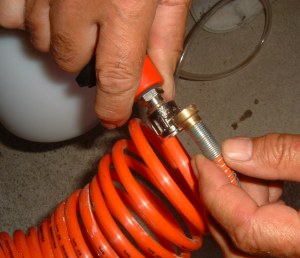
Brake bleeding on a saloon car
Caution : Prior to bleeding the brake system, protect the body work of your car as brake fluids can be very corrosive to some paints.
- Insert the pipe end into the hydraulic oil tank. Operate the trigger of the bleeder. Used fluid is automatically pumped out by the bleeder probe. (Fig C).
- Fill in the tank with a convenient new oil (Fig. D). The brand of the hydraulic fluid is stated in the handbook of the vehicle.
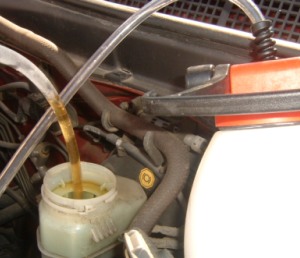
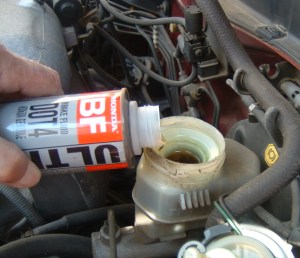
Bleeding wheel master cylinders :
To access bleeding screws, first remove the wheels of the vehicle. Use the jack to remove the corresponding wheel. For safety reasons, always fit a stand (Fig. E and F).
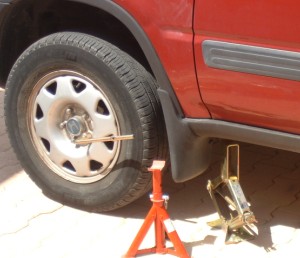

Bleeding the 1st wheel
To access the bleeding screw, remove the rubber cap (Fig. 1).
Using a cloth, clean the screw, then slightly oil it (Fig. 2).
Slightly untighten the nut (Fig. 3) using a convenient wrench.
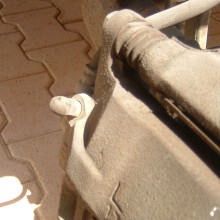

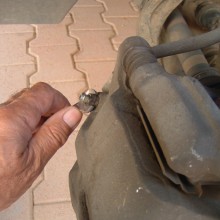
Insert the rubber end into the bleeding screw.
Unscrew the bleeding screw (fig. 4) and operate the trigger of the bleeder. The brake fluid floods into the pipe. Some air bubbles can be seen (Fig. 5).
Release the trigger as soon as the fluid gets clear. Then tighten the bleeding screw, unplug the cannula, fit again the protective cap on the bleeding screw (Fig. 6). Bleeding the circuit of this wheel is finished.
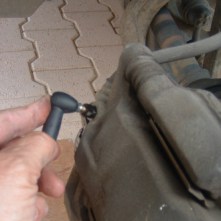


Apply the same procedure to the other wheels.
Always control the level of hydraulic fluid and top up to the top to prevent air from coming into pipes. Evaluate the quantity of fluid required, each time, before the fluid gets clear. This quantity depends on the vehicle. It is always more important on the rear axle drive.
Wheel cylinder bleeding sequence: First refer to the handbook of your vehicle. A preferred procedure is sometimes recommended.
End of the procedure: Control the level of fluid and top up is necessary. There are two marks: a min. level and a max. level marks. We recommend not filling up to the max. level. Draw your own mark on the fluid tank to make regular controls easier. In case of abnormal consumption of hydraulic fluid, it will show immediately.
Note : You can use yourall purpose bleeder to bleed the fluid of the clutch control system or of any other system. Please refer to the handbook of your vehicle or to any other specialized technical book.

